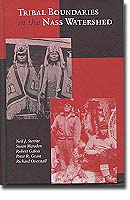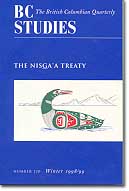Attention: this is very old content, revived mostly for historical interest.
Many of the pages on this site
are still useful, but please bear in mind that they may be out of date. (Especially, do not try to use contact information, phone numbers, etc.
found on these pages unless you couldn't find anything more recent.)
See here for more information.
E-mail questions to: gitanyowchiefs@kermode.net
The following books and videos will provide more information about
the Gitanyow People and the Land Question.
Literature
H. Glynn-Ward. The Glamour of British Columbia.
MacMillan Canada, St. Martin's House, Toronto, 1926.
Glynn-Ward writes about his meetings with the first peoples of British
Columbia, including the Kitwancool (Gitanyow) People. He describes the
"Grease Trail" in undisputed Kitwancool territory, the
protectiveness of the people and their willingness to
"prosecute" those who would trespass. A description of the
healing methods and medicines are also included.

Neil
J. Sterritt, Susan Marsden, Robert Galois, Peter R. Grant and Richard
Overstall. Tribal Boundaries in the Nass Watershed. UBC Press,
Vancouver, 1998.
Written as part of the negotiations between the Gitksan, Gitanyow and
Nisga'a who have competing territorial claims of ownership and
jurisdiction in the upper Nass River watershed. The most significant
body of evidence ever compiled to show the existence of Aboriginal Title
anywhere in North America. This book can be ordered through 'Ksan
Historical Village Giftshop for $29.95CAD plus shipping. Call 'Ksan
toll-free at 877-842-5518.
See a review of Tribal Boundaries in the Nass
Watershed by Jay Miller from the University of Washington at
the bottom of this page.
 N.J.
Sterritt. "Competing Claims Ignored", B.C. Studies: The
Nisga'a Treaty, No. 120 (Winter 98/99). UBC Press, Vancouver. N.J.
Sterritt. "Competing Claims Ignored", B.C. Studies: The
Nisga'a Treaty, No. 120 (Winter 98/99). UBC Press, Vancouver.
 Terry
Glavin. A Death Feast in Dimlahamid. New Star Books, Terry
Glavin. A Death Feast in Dimlahamid. New Star Books,
Vancouver, 1990.
Marius Barbeau. Totem Poles of the Gitksan, Upper Skeena
River British Columbia. Nat'l Museum of Man, Ottawa, Canada, circa
1929.
This book is divided into information on Totem Poles by village, i.e.
Gitwinkul (Gitanyow), Gitwangak, etc. Descriptions of the Totem Poles of
the Gitanyow (Kitwancool) Huwilp (Chief's Houses) such as Luuxhon and
Willitsxw. The estimated ages of poles are given with photographic
plates.
NOTE:
For further reading on the extensive work of
anthropologist, M.Barbeau with specific reference to the
Gitanyow/Kitwancool traditional territories please make a formal request
to the Traditional Use staff at the Gitanyow Huwilp Society (250)
849-5373 fax: 849-5375 or e-mail us at gitanyowchiefs@kermode.net
. For a complete listing of recommended readings please contact the Gitanyow
Huwilp Society in Gitanyow, BC or the Aboriginal Affairs Branch,
Ministry of Forests in Victoria, BC, Canada.
Videos
Escape from Okalla Reserve - the Gitanyow Land Question.
A 20-minute look at the Gitanyow Treaty Process and the frustration felt
by the lack of Government "movement" on the land question.
Includes an analysis of the Nisga'a Final Agreement's impact on the
Gitanyow people. Produced by stoneboy Productions in
association with Ghostrattle Entertainment for the Gitanyow
Hereditary Chiefs, 1999.
Gift From the Elders - Traditional Foods Study
Traditional food gathering and preparation techniques featuring the
elders of Gitanyow. Produced by Gryphon Productions in
Association with the people of Gitanyow.
|
Return to book cover
Tribal Boundaries in the Nass Watershed
Neil J Sterritt. Susan Marsden, Robert Galois, Peter R. Grant, and
Richard Overstall
In early August of 1998, newspapers around the world heralded a landmark
agreement between Canada and the Nisga'a (formerly Nishga) Nation. Seen as a
model for correcting the atavistic colonial policies of the province of British
Columbia , Nisga'a self-government was set up over 750 square miles of the Nass
River.
Using their political and public relations savvy, Nisga'a convinced Canadian
officials that the Nass was entirely their river, much in keeping with common
anthropological and legal principles holding that each river throughout the
Americas was home to a single cultural and tribal entity. In many cases, this
has been true. But for the Nass, whose very name is from the Tlingit just to the
north in Alaska and means bounty, bellyful, it has never been the case.
This book, meticulously drawing upon both European academic sources and
native traditions of diplomacy, scrutiny, and respect, forcefully argues
multiple homelands. Scholars of and for the Gitksan have long researched the
Nass, but their findings have largely been ignored because they show a truly
complex situation, far from the simplistic "one nation, on river"
argument favored by lazy courts.
Among the bounties of the Nass that attracted and fed large populations was
the early spring run of candle fish (eulachon, locally known as hooligans),
which arrived so rich in life-sustaining oil that one Coast Tsimshian word for
them is savior. The rendering of and trade in this oil from the mouth of and
Nass made Coast Tsimshian chiefs very wealthy, encouraging them to sponsor
sophisticated artworks, dramas, rituals, feasts, and, combining features of all,
potlatches, the hallmark of this region.
Thus, after the Tlingit were driven north from the Nass beginning about 1,000
years ago, the Coast Tsimshian occupied the mouth during peak fishing season,
the Nisga'a were mid river, beyond the estuary of Portland Inlet, and the
Gitksan, close relatives in language and culture, occupied the head-lands.
Grease trails were the routes used by slave to move rendered oil overland
between the Nass and Skeena rivers . The Courts, government, and recent rulings
have all but ignored this complex international situation. The book starts with
the Adaawkl, sacred histories preserved by ranking members of North Coast
communities, often the head of a communal household. My own recent study of
those histories of the Coast Tsimshian found at least 15 eras associated with
named people and places that cover the last 10,000 years. Claims are attributed
not to individuals but to houses, crest, and other kinship groupings. The named
leader only serves as steward for the corporate right of the household.
Chapters trace the claims of the modern Gitanyow (formerly Kitwancool) and
three Gitksan communities. Comparisons with the Nisga'a own claims and with
European records detail when, where, and how Gitksan lived on their lands in
full view of visitors and neighbors. The conclusion summarizes all of the these
complexities.
The book is filled with appealing maps, labeled with both native and English
names, and contains supporting statements from inland nations. It is too bad
that arduous attention to detail and such a convincing historical overview have
failed repeatedly to convince the provincial legal mind.
Jay Miller, University of Washington
Return to book cover
modified May 7th, 2002

 N.J.
Sterritt. "Competing Claims Ignored", B.C. Studies: The
Nisga'a Treaty, No. 120 (Winter 98/99). UBC Press, Vancouver.
N.J.
Sterritt. "Competing Claims Ignored", B.C. Studies: The
Nisga'a Treaty, No. 120 (Winter 98/99). UBC Press, Vancouver. Terry
Glavin. A Death Feast in Dimlahamid. New Star Books,
Terry
Glavin. A Death Feast in Dimlahamid. New Star Books,